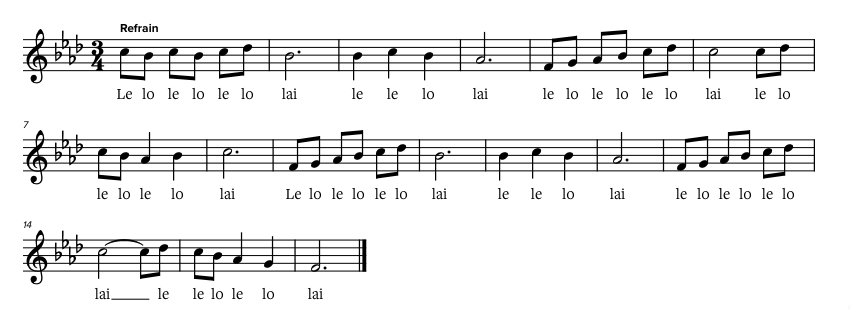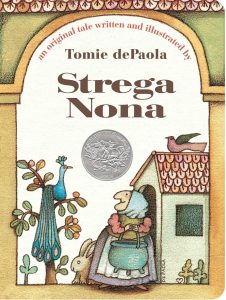Lesson 2: Exploring “Cu Ti Lu Dissi”
Aim: How are meter and rhythm used to support dancing?
Summary: Students will learn to sing “Cu Ti Lu Dissi,” learn 3/4 meter, dance the waltz, and discover Sicilian folk instruments.
Materials: Musical Explorers digital resources, everyday-object percussion
Standards: GA – ESGMK.PR.1, ESGMK.RE.3, ESGMK.CN.2, ESGM1.PR.1, ESGM1.RE.1, ESGM2.PR.1, ESGM2.RE.1, ESGM2.CN.2
Vocabulary: meter, waltz
See Glossary →
Sing “Cu Ti Lu Dissi”
- Listen to “Cu Ti Lu Dissi,” Track 5.07.
Track 5.07 – “Cu Ti Lu Dissi”
- Learn the words and the melody to the chorus, using “Cu Ti Lu Dissi” pronunciation, Track 5.08, and “Cu Ti Lu Dissi” chorus, Track 5.09.
Track 5.08 – “Cu Ti Lu Dissi” Chorus Pronunciation
Track 5.09 – “Cu Ti Lu Dissi” Chorus
- Learn the melody to the wordless refrain using “Cu Ti Lu Dissi” refrain, Track 5.09.
Track 5.10 – “Cu Ti Lu Dissi” Refrain
- Read the lyrics aloud to your students and discuss.
- Many Sicilian love songs are about heartbreak; some say this song is about choosing love over pain.


“Cu Ti Lu Dissi”
Text:
Cu ti lu dissi ca t’haju a lassari?
Megliu la morti e no chistu duluri
Chorus:
Ahj, ahj, ahj moru moru moru moru
Ciatu di lu me cori, l’amuri miu si tu
(x2)
Refrain:
Le lo le lo le lo lai …
(x2)
Cu ti lu dissi a tia nicuzza
lu cori mi scricchia a picca a picca a picca a picca
(Chorus) x2
(Refrain) x2
Lu primu amuri lu fici cu tia,
E tu schifiusa ti stai scurdannu a mia.
(Chorus) x2
(Refrain) x2
Translation:
Who told you I have to leave you?
I’d rather die than suffer such pain.
Chorus:
Ay ay ay ay I die, I die, I die, I die
Breath of my heart, you are my love
(x2)
Refrain:
Le lo le lo le lo lai …
(x2)
Who told you little one?
My heart is torn, little by little.
(Chorus) x2
(Refrain) x2
You were my first love, and now you are cruelly forgetting me.
(Chorus) x2
(Refrain) x2
Learn about the Composer
Rosa Balistreri was born in Sicily during a time of a feudal system that left the people with little control of their lives. She faced many hardships throughout her life. Her music often captured the feelings, strife, and strength of Sicilians, and her songs are still popular today. She explained about herself, “Politics and protests can be done in different ways: I love to sing. But I’m not just a singer, I’m quite different, let’s say I am an activist who protests with a guitar.”
Rosa Balistreri (1927-1990)
Meter in “Cu Ti Lu Dissi”
- Listen to “Cu Ti Lu Dissi,” Track 5.06, and create different movements to illustrate the 3/4 meter: STRONG-weak-weak, STRONG-weak-weak. You can use swaying, hand motions, foot work, and levels (e.g., down and up).
Track 5.07 – “Cu Ti Lu Dissi”
- Explore the basic rhythm played by the tamburello, Track 5.11. Note that there are two different rhythms, both in groups of three. Each measure is divided into three quarter notes. In the last measure, each quarter note is divided into triplets.
Track 5.11 – Basic Tamburello Rhythm

- Using the Basic tamburello rhythm, Track 5.11 as a guide, play the tamburello rhythm, starting out slow and speeding up. Once students have practiced the basic rhythm, they can experiment with improvising as the tamburello traditionally does.
- Use the quarter notes and triplets as the two building blocks, varying the number of quarter notes and the number of triplet sets.
- The tamburello rhythm with variations, Track 5.12, demonstrates this activity.
- The improvised tamburello rhythms, Track 5.13, demonstrates a more elaborate improvisation.
Track 5.12 – Tamburello Rhythm with Variations
Track 5.13 – Improvised Tamburello Rhythm
Waltz to “Cu Ti Lu Dissi”
- Sicilian folk music is often accompanied by dancing. “Cu Ti Lu Dissi” is a waltz, which is a dance form found in many cultures.
- A waltz is a dance in 3/4. Beat 1 is strong and beats 2 and 3 are weak.
- Learn a basic waltz step. Students will step down on the strong beat and up on the weak beats (DOWN-up-up): Ask students to form a circle.
- Beat 1 (DOWN): Step forward on your right foot and bend your knee as you plant your foot down.
- Beat 2 (up): Bring your left foot to meet your right, stepping on your tiptoes.
- Beat 3 (up): Step on tiptoes in place on your right foot.
- Repeat the three steps beginning with your left foot.
- Once students are comfortable with the movement and can do it up to speed, play “Cu Ti Lu Dissi,” Track 5.07
- If they master the waltz moving in a circle, try it paired up.
Creative Extension: Sicilian Folk Instruments
Using SG33, students will learn about four instruments that characterize Sicilian folk music. Read the descriptions of each instrument and discuss them with your students. Listen to an example of each instrument using Tracks 5.14-5.17.
Track 5.14 – Tamburello Demonstration
Track 5.15 – Marranzano Demonstration
Track 5.16 – Guitar Demonstration
Track 5.17 – Organetto Demonstration
Creative Extension: Learn About Sicily
Literacy Extension: Strega Nona
Musical Word Wall
Add the words meter and waltz to the Musical Word Wall.
See Glossary →
PDF Downloads
↓ SG33 Sicilian Folk Instruments
↓ SG34 Learn about Sicilian History
↓ SG35 Learn about Sicilian History (cont.)
Audio Tracks
Track 5.07 – “Cu Ti Lu Dissi”
Track 5.08 – “Cu Ti Lu Dissi” Pronunciation
Track 5.09 – “Cu Ti Lu Dissi” Chorus
Track 5.10 – “Cu Ti Lu Dissi” Refrain
Track 5.11 – Basic Tamburello Rhythm
Track 5.12 – Tamburello Rhythm with Variations
Track 5.13 – Improvised Tamburello Rhythm
Track 5.14 – Tamburello Demonstration
Track 5.15 – Marranzano Demonstration
Track 5.16 – Guitar Demonstration
Track 5.17 – Organetto Demonstration

